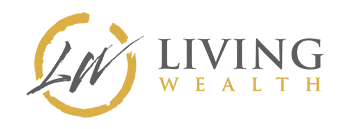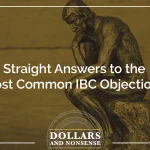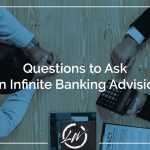In this episode, we are continuing our question-answering series. We’ll discuss some of the most common questions we receive from our clients. And today, the focus is going how and when to use your policy.
How and When to Use Your Infinite Banking Policy:
- When do I start a new policy?
- How soon can I take a loan out against the policy?
- What should I be doing with this policy?
- What should I use it if I have one?
- How long does it take to use it?
- What do other people use it for?
Related Episodes:
- E86: How to Get The Best Results From Infinite Banking
- E74: 3 Disastrous Infinite Banking Myths You Need to Know
- E69: 3 Big Myths Banks Make You Believe About Money
Podcast transcript for episode 87: Most Common Infinite Banking Questions
Nate: In this episode, we are continuing our question answering series. We’ll discuss some of the most common questions we receive from our clients. And today, the focus is going to be on how and when to use your policy. Then things you need to watch out for and be careful of while you’re using them. She’s Holly, and she helps people find financial freedom.
Holly: He’s Nate, he makes sense out of money. This is Dollars and Nonsense. If you follow the herd, you will be slaughtered.
Nate: All right, in our last podcast we were discussing one of the most common questions that we receive. Especially from those who are already doing it, infinite baking and have a policy. And that question is, when do I start a new policy? So we get that question all the time. But as well after that, probably the next most common questions we get from both clients that already have policies and also individuals who are looking into this concept. The most common question is, well, what the heck am I going to be doing with this policy? What should I use it for if I have one? What should I use it for if I’m thinking about getting one? How long does it take to use it? What do other people use it for? All those types of things.
Today Holly and I are going to talk about if you’re getting into infinite banking, here’s a lot of things you should know about using your policy. And here’s some ideas that hopefully you can glean some things off of to put your policy to work.
But anyway, Holly, let’s just start with the most basic one. I think there’s a lot of misconception out there of how long it takes to be able to use a policy. There’s things floating around, it takes years before you can use it. There’s things floating around, I got to build it up to a certain amount. But in reality, how soon do most clients take their first policy loan from a policy?
Holly: If they’re paying annually, it’s within the first 30 to 45 days. I’m going to say if you are paying monthly. What we like you to do is actually wait about six months before you take your first policy loan. But in reality, the short answer is within 30 days after you have placed that policy in force, you can do your first loaning. For Nate and I, we very much promote not waiting to use that money and letting it sit there. Especially if you have significant debts or bills you need that money to pay for. Such as credit card debt.
Nate: Holly, you’re right. It doesn’t take long at all. I mean, even on a monthly policy, you can take a loan right away if you want. But since you’re only putting in money every month after your very first month’s premium. You’re probably don’t have a ton of money left. That’s why we suggest building up for a little while so we can take a big chunk out and do something bigger with it. But regardless, it doesn’t take long at all. I want to cut that off at the pass there.
And then talk about things that most people are doing. I think a lot of people, Holly, get the idea of using it for cars. Because that’s just the most common thing seen in the infinite banking world, is people financing cars on the policy.
Holly: Yeah. But I think the reality is a lot use it for credit card debt, for student loans, for going to school, education, for vacations. It’s endless. But most common I would say, is credit card debt and travel. As well as vacations and education is huge right now. In paying for that education or being able to pay down some of your loans. That’s the most common.
I mean, I have some that are younger that use it and I’m in Southern California. So they use it for, “Hey, I buy surf gear every year at this point in time. Will I have money to buy my surfing equipment?” As much as you say, “When can you take the loans?” It’s endless. What are people buying with it? I think it depends on your area and where you live. But I also think it depends on if you only view it as, “I can only buy something big. Or what is something small that I can use that for and purchase?” I mean, I use the example, our first policy loan was for a GPS.
Nate: Really? That takes you back.
Holly: It brings you back. It was $600, Nate-
Nate: Holy cow.
Holly: And that was for us, like huge. And we paid it back over a year.
Nate: I think my very first time I used it was for my wife’s engagement ring. Shortly after I actually had the policy in force.
Holly: Like what you said Nate, within three months having the policy enforced is when we took our policy loan.
Nate: So there’s certainly no reason to wait. And I do think, for the vast majority of people. Whenever you get into this banking world, we really don’t like other banks all that much. I think most people get the idea that, “Yeah, if I’m going to become my own banker. That probably means I should be paying down my debt.” So that is probably the most common use of the policy is someone gets started … is that we’re going to take over third party debt.
The problem is some people get in their head that, “Well, if I don’t have any debt, if I don’t owe the bank anything. Then what’s the point of me even doing this?” I mean, they get the idea that it’s essentially a get out of debt system. The whole goal is not to have debt period and still practice banking. That would mean that as soon as we’re done getting people out of debt, then they should shut the policy down. And there’s no more value to be made from using your own bank.
Announcer: Come meet Holly, Nate, and the rest of the Living Wealth team in person. Visit livingwealth.com/events to sign up for our free workshop in your area. These beginner and advanced workshops are an excellent chance for you to understand better what it means to pay yourself first. And the impact infinite banking can have on your life. They’re hosting workshops in Orlando, Florida, Juno, Alaska, Lawrence, Kansas and many more. Again, visit livingwealth.com/events and sign up for a free workshop in your area. Hope to see you there.
Nate: The most common across the board is typically, taking over debt. But then after that we find that it does start falling into probably the next most common way is buying some sort of asset, or an investment, or other things of that nature. Very common in the world of real estate. Very common to use your policy to do that. We do encourage … and you heard us on this podcast, encourage people to take ownership of their financial education. So that you can actually get good at something, get good at investing in something. Then you can use your policy to help power that.
Same thing goes if you’re in business … if you’re an entrepreneur, honestly the amount of times you can use your policy truly is infinite. It’s just endless. You should probably be using your policy to fund almost everything you’re doing in your business. There’s some tax write offs you can create with interest expense that you really should be taking advantage of.
But as Holly said, even just things like vacations. They got to be paid from some place. Most people just saving up money whether they realize it or not. Whether it’s a set basis or not, to go on vacation. That money, you should get that out of the bank. You should put that money in your own bank and then use the money. Then recapture the money over the next 12 months so you can go again. Just cycle it through your policies and make a profit to go on vacation. That’s what you should be doing.
The same thing goes for so many other things. I guess we can keep on giving ideas. I mean that’s the whole goal of this podcast, for those of you who are listening. Holly and I, we wanted to answer some questions. But also just stir your imagination, give you some ideas of how you could use this thing.
Holly: And I think, Nate, the point is that we want people to understand. Nobody is limiting them and saying, “This is what you have to use it for.” It is literally for whatever they want to use it for. Whether it be an engagement ring, a GPS, a down payment on a house, a car. Whatever it is, it is your money you get to use and nobody is telling you, “You have to go and use it for this.” Going on vacation and letting it be a vacation. Enjoying every single moment because you know that you took the money out of your policy that’s going to pay for this vacation. As you pay it back, you’re actually going to have created more money by paying it back and using your policy to do it.
So I think that’s the key here, is to understand that we can name off all the things you can use it for. But it’s so infinite that whatever you want to use it for, you can.
Nate: You’ve got to keep the big thing, the big thing. So we can talk about a little ideas, little strategies, different things like that. But at the end of the day you’re trying to redirect cashflow that used to be stored in a bank or used to be made in payments to a bank. And redirect that into your own policy so that you can create profit where there used to not be any profit. What’s really catching steam as an idea that people are just latching onto for very good reason is charitable giving. An income tax more in the world of a business owner. I’ve seen W2 and I’m sure you have, too. Individuals who work it out to where they actually can finance their income tax with policies. Then pay it back and pay for the tax through that. But it’s certainly is a lot more difficult whenever a chunk of taxes are taken out of your check against your will. [inaudible 00:09:24] Uncle Sam. But as a business owner having to pay taxes, actually having to write checks for them out of your pocket. Stop leaving that money in the bank, start using your policy to fund those things.
The same thing goes for charitable giving. Many of us give to various charities and ministries that we support. Instead of just building up cash and sending it over to them, why not use your bank? Why are we still using other people’s banks to do that? Most of us get on the flow of maybe doing a large year- end gift each year. Then we pay ourselves back over the course of the following year just like we used to … maybe if you’re [inaudible 00:09:59] then you used to give on a regular basis.
Instead of giving it directly to the church, just give it to them all up front at the end of the year for the whole entire next year. Then you pay yourself back with the same cashflow into the policy. You’ll happen to find at the end of that year, that you have all of the money that you need plus you made some money. You literally just made some money to give. It’s really makes even a bit more fun. You can get more than you thought you could.
Holly: When you start using it and seeing how you can use it. It actually makes even like charitable giving enjoyable. Or even vacations, worrying about, “I’m gone and I maybe am not earning money or doing this and that.” You actually do get to enjoy the vacation. But it also means, what do you have to watch out for, as well? Like what can we not do? I would say one of the biggest things with individuals is they take that loan out. But they don’t ever have any intention of repaying it.
Nate: True. I guess we can make a caveat there, too. I mean there’s some instances where repaying it is not as important as other instances. At least what I’ve found. If you’re coming from the world where all of your money used to go into a 401k or some retirement program style system. Where you really couldn’t get the money back, just kind of locked in there. Then we start redirecting money into a policy and you’re using it. That’s new power that you used to not have and you do need to treat it with respect or else you could just blow all your money. We do want to avoid that.
So, exactly right, Holly. If you’re taking out loans and you find yourself never repaying any of them. You’re just throwing money down the drain on all sorts of things. You’re probably not doing it right.
Holly: Nope. You’re no.
Nate: Like I found, Holly, that at times if I was going to use a policy loan to make an investment where there may not be a return for a period of time. It’s really not the end of the world to pay it back on a short notice or to get into a structure repayments schedule, necessarily. If you’re using the policy to do things that are actually earning money, appreciating of sorts. Even whenever I’ve used my own policy to help fund the premium on the next policy. I mean, sure if I can repay the policy loan that I took to do that, great. If I can’t, well it’s not really, like I just spent the money on something. I’ve just moved into a different policy and it’s growing there. If I repay it, great. If I don’t, that’s fine.
But if I go out and buy a car and that thing’s going to be worth nothing in five years down the line. So if I don’t repay it, I’m first off, I’m not going to have any money to go buy the next car. I’m not going to have an asset to show for it. I’m just out the money. So we do want to try to avoid doing that. We actually want to build wealth by using the policy.
Holly: I think the power of it, too, Nate, like you said. You can maybe not pay it back if you don’t want to. If you’re using it to buy another policy. Or you can delay the payment back to yourself if money’s tight at a certain point in time. Or I know that I’ve done that, that I maybe wait six months or even a year before I start the loan repayment. Just because of how I’m moving money around. But I think one of the keys is understanding that it’s really a loan to yourself. That’s the power of this, is the freedom of somebody not breathing down your neck. If you can’t make the payment even that month. Maybe we defer it for a month, right?
Nate: Yeah, sure. Whenever you know that you’re going to get all the principal and all the interest back. Whenever you repay yourself in the policy. It really doesn’t matter how long it takes you to repay yourself. There’s freedom in there. If you know you’re going to get all the money you pay back in principle and interest, plus make a profit. The goal is simply to repay. It doesn’t have to be fast. We can talk even more about that a different time of some of that to make sense to spread out your repayment terms. To free up money to help fund new policies and things like that.
That’s the way the world thinks. Whenever you’re paying somebody else back and you have a loan from somebody else. You want that thing to be gone as fast as possible because you’re not going to get any principal or any interest back. It’s all down the drain. It’s all going to somebody else. If you get it all back, you can pay it off now. You can pay it off later. You’re going to get it all back. So it takes the pressure off. The key is just to get in the practice of doing it. The key is just to start doing something as opposed to nothing.
Holly: That’s what we want you to do is to be excited about the fact that you have this life insurance policy, your own infinite banking account. Your own thing you have created. And that you’re going to be able to use it for what you want to do, when you want to do it. Even the repayment is how you want to repay it. Just understanding that there is so much freedom in the ability to know that you’re in control. As well as the fact of that you have flexibility with it is what allows it to be so fun. I’m like you, Nate. I don’t mind paying premiums. I also don’t mind loan repayments. But I really like looking and seeing how my money grew.
Nate: Yeah, yeah. For those of you who are just starting off, I mean, I started out in year zero just like everybody else. I’ve gotten new policies, I’ve got old policies. But man, it gets really fun whenever you repay a loan and you’re five years down the road. And you’ve got a lot more money than you put in for the in loan, in cash value available.
The same thing goes for a premium. Like when you get to the point where you’re actually paying a premium and your cash values increasing by quite a bit more than you’re paying in premium. That’s when you get to realize what we’re teaching on this podcast. But the only problem is it takes time and this isn’t a get rich quick scheme. If you actually put in the time and put the money in, you’re going to get there. You’re going to love it.
There’s really nothing that you can do to stop the train when it starts moving. You can’t really blow it up. I mean you could try and maybe you can make it work, but it’s kind of hard if you know what you’re doing to blow the thing up. Anything else on how to use policies, Holly?
Holly: I would just say that even if you want to let us know how you’ve used your policy. I’d love to hear and say, “Hey, this is what I did.” Because I love hearing how everybody uses their policy and what they did with it. So don’t be limited to what Nate and I are saying. Really go out and find what you’re passionate about and invest in that through a policy.
Nate: Absolutely. And if you have questions, just shoot us an email. Nate@livingwealth, Holly@livingwealth.com. Shot us an email, we’re happy to answer your questions to give you some advice. Love to hear from you on what you’ve been using your policy to do. If you’ve been using it in some cool way that would blow our minds, that’d be awesome.
But with that being said, we are probably out of time. So this has been Dollars and Nonsense. If you follow the herd, you will get slaughtered.
Holly: For free transcripts and resources, please visit livingwealth.com/e87.









